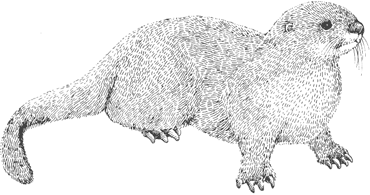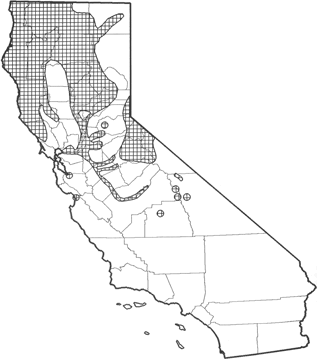
River Otter
Distribution, Abundance, and Seasonality
Uncommon, yearlong resident of rivers, large streams, lakes, wetlands, estuaries, and coastal areas. Occurs along river drainages in the North Coast, Klamath, and Cascade Ranges; distribution patchy in the Sierra Nevada (Grinnell et al. 1937). The eastern drainages in Alpine, Mono, and Inyo cos., and the Sacramento-San Joaquin drainages and delta also support river otters (Kirk 1975). Numbers greatly reduced by trapping in the past, but increasing under protection (Schempf and White 1977). Most numerous at foothill elevations.

Range Map
Specific Habitat Requirements
Feeding: River otters mostly are carnivorous. Primarily feed on fish, crayfish, and other crustaceans. Also eat amphibians, mollusks, other aquatic invertebrates, carrion, a few mammals and birds, and occasionally fruits, such as blueberries (Toweill 1974). Swim, dig on bottom of watercourses, search and pursue on land to obtain prey. Individuals may hunt alone, or with others (Sheldon and Toll 1964). In Suisun Marsh, crayfish occurred in 98% of 118 scats in 1972-73 (Grenfell 1978).
Cover: Cover provided by thickets, tall wetland plants, hollow logs, stumps, snags, and burrows and other cavities.
Reproduction: Nest in burrows and cavities in banks, rocks, trees, stumps, in hollow logs, in deserted beaver burrows, in thickets, or on platforms made of wetland plants. Nests lined with dry vegetation, and occur within 0.8 km (0.5 mi) of water.
Water: River otters drink water.
Pattern: Suitable habitat consists of riparian and other wetland vegetation associated with a large, permanent water source.
Species Life History
Activity Patterns: Active yearlong. Mostly nocturnal, but frequent diurnal activity.
Seasonal Movements / Migration: Non-migratory, but may travel long distances along watercourses, or even over land in search of a mate, or a new living area.
Home Range: Home ranges may extend an average of 24 km (15 mi), or more, along rivers and streams (Haley 1975). Travel distance is highly variable, and related to food supply, suitable habitat, and inherent wandering. May travel 80-96 km (50-60 mi) along rivers and streams during a year (Liers 1951).
Territory: No information available. Individuals establish scent posts using their urine, feces, and musk.
Reproduction: Most young probably born in March and April in California. Females have postpartum estrus. Gestation period 288-380 days, including delayed implantation (Liers 1951). The single litter per yr averages 2.6 young (range = 1-6). Young weaned in about 4 mo. Female and young remain together 8 mo., or more Females mature sexually in second yr, but males reported not to breed successfully until 5-7 yr (Mase et al. 1981).
Niche: Few predators other than humans. Generally do not affect population numbers of game fish; may improve sport fishing because they eat mostly slower, nongame fish.
Sources & References
California Department of Fish and Game, 1999.
California's Wildlife, Sacramento, CA.
Written by: C. Polite, reviewed by: M. White, edited by: M. White
Grenfell, W. E. Jr. 1978. Food habits of the river otter in Suisun Marsh, central California. Cal-Neva Wildl. 1978:65-73. Grinnell, J., J. S. Dixon, and J. M. Linsdale. 1937. Fur-bearing mammals of California. 2 Vols. Univ. California Press, Berkeley. 777pp. Haley, D. 1975. Sleek and savage: North America's weasel family. Pacific Search Books, Seattle, WA. 128pp. Kirk, D. 1975. River otter survey progress report. Calif. Dep. Fish and Game, Sacramento. Nongame Wildl. Invest. Job II-1. 10pp. Liers, E. 1951. Notes on the river otter. J. Mammal. 32:1-9. Maser, C., B. R. Mate, J. F. Franklin, and C. T. Dyrness. 1981. Natural history of Oregon coast mammals. Pac. Northwest For. And Range Exp. Sta., USDA, For. Serv., Gen. Tech. Rep., PNW-133. 496pp. Newberry, D. W. 1973a. A contribution towards a bibliography of California furbearers. Calif. Dept. Fish and Game, Spec. Wildl. Invest., Sacramento. 148pp. Schempf, P. F., and M. White. 1977. Status of six furbearer populations in the mountains of northern California. U.S. Dep. Agric., For. Serv., San Francisco, Calif. 51pp. Sheldon, W. G., and W. G. Toll. 1964. Feeding habits of the river otter in a reservoir in central Massachusetts. J. Mammal. 45:449-455. Toweill, D. E. 1974. Winter food habits of river otters in western Oregon. J. Wildl. Manage. 38:107-111.
California Animal Facts | California's Wildlife